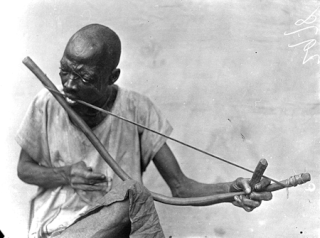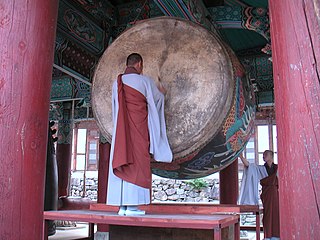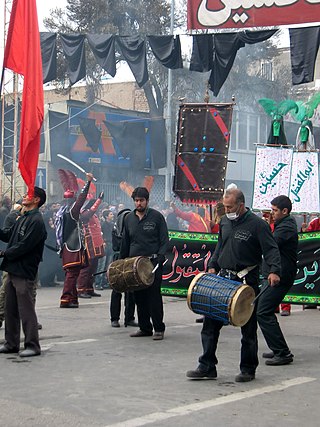Related Research Articles

Overtone singing, also known as overtone chanting, harmonic singing, polyphonic overtone singing, or diphonic singing, is a set of singing techniques in which the vocalist manipulates the resonances of the vocal tract to arouse the perception of additional separate notes beyond the fundamental frequency that is being produced.

The musical bow is a simple string instrument used by a number of African peoples as well as Indigenous peoples of the Americas. It consists of a flexible, usually wooden, stick 1.5 to 10 feet long, and strung end to end with a taut cord, usually metal. It can be played with the hands or a wooden stick or branch. It is uncertain if the musical bow developed from the hunting bow, though the San or Bushmen people of the Kalahari Desert do convert their hunting bows to musical use.

Indigenous music of North America, which includes American Indian music or Native American music, is the music that is used, created or performed by Indigenous peoples of North America, including Native Americans in the United States and Aboriginal peoples in Canada, Indigenous peoples of Mexico, and other North American countries—especially traditional tribal music, such as Pueblo music and Inuit music. In addition to the traditional music of the Native American groups, there now exist pan-Indianism and intertribal genres as well as distinct Native American subgenres of popular music including: rock, blues, hip hop, classical, film music, and reggae, as well as unique popular styles like chicken scratch and New Mexico music.
Traditional Inuit music, the music of the Inuit, Yupik, and Iñupiat, has been based on drums used in dance music as far back as can be known, and a vocal style called katajjaq has become of interest in Canada and abroad.
Blackfoot music is the music of the Blackfoot people. Singing predominates and was accompanied only by percussion.

Ceremonial drums are membranophones and idiophonic slit drums, which are played in a ritual context cult, religious or ceremonial social occasions by indigenous peoples around the world, often accompanied by singing or chanting.
Botswana is an African country made up of different ethnic groups, although Batswana are the majority of the population. Music is a large part of Botswana culture, and includes popular and folk forms. Botswana church choirs are common nationwide.

The Music of Samoa is a complex mix of cultures and traditions, with pre- and post-European contact histories. Since American colonization, popular traditions such as rap and hip hop have been integrated into Samoan music.

Music of Jammu and Kashmir reflects a rich musical heritage and cultural legacy of the Indian-administered union territory of Jammu and Kashmir. Two different regions of Jammu and Kashmir consists the Jammu region and Kashmir Valley. Music of Kashmir Valley has influences of Central Asian music while music from Jammu region is similar to that of other regions of North India.

The music of West Africa has a significant history, and its varied sounds reflect the wide range of influences from the area's regions and historical periods.

In many parts of sub-Saharan Africa, the use of music is not limited to entertainment: it serves a purpose to the local community and helps in the conduct of daily routines. Traditional African music supplies appropriate music and dance for work and for religious ceremonies of birth, naming, rites of passage, marriage and funerals. The beats and sounds of the drum are used in communication as well as in cultural expression.

The naqareh, naqqāra, nagara or nagada is a Middle Eastern drum with a rounded back and a hide head, usually played in pairs. It is thus a membranophone of the kettle drum variety.
Baka music is the music of the Baka people who come from the southwestern Central African Republic. Most Baka music is vocal and it is polyphonic. The music is based on repetitive melody and rhythm, with little variations and a lot of improvisation. Music and dance is important to them. It is done to prepare for a hunt or show a skill. Music is also used in daily life for healing rituals, initiation rituals,traditional stories, group names, and for entertainment. Dance and music helps bring groups together. This helps people to become friends while they share their surviving techniques.

Umxhentso is the traditional dancing of Xhosa people performed mostly by Amagqirha, the traditional healers/Sangoma. Ukuxhentsa-Dancing has always been a source of pride to the Xhosas as they use this type of dancing in their ceremonies.
Nofinishi Dywili (1928–2002) was a traditional Thembu musician who achieved much recognition throughout her lifetime. She is regarded as the master of "uhadi" music and the master of Xhosa song productions such as The Bow Project.
The Uhadi, a musical bow, is a traditional Southern African Xhosa musical instrument. It is a large unembraced musical bow which is attached to a resonator and played by percussion. The length of the string bow ranges from 115 to 130 centimeters. Similar musical bows in Southern Africa include the ‘’thomo’’ in Sotho music and the ‘’ugubhu’’ in Zulu music.

The Dammam is a large double-headed cylinder drum or frame drum played by Shias in Iraq and Iran in religious ceremonies. The dammām is usually struck with the left hand and a curved stick in the right hand, especially during passion plays in the mourning month of Muharram or to wake up the devotees early in the morning of Ramadan.

The Umrhubhe, a mouth bow, is a traditional indigenous instrument of the AmaXhosa in South Africa. It is played by creating friction, rubbing the string with a reed or scraped stick, while using the mouth as a resonator. Umrhubhe holds cultural significance among the Xhosa people, playing an important role in both social and musical education.

Isitolotolo is the Xhosa name for the Jew's harp, a small musical instrument introduced to South Africa by European traders in the 19th century. The 19th century European traders brought metal Jaw’s Harps to Africa. In South Africa, the instrument became popular with traditional African musicians because of its affordability and portability. In isiXhosa, the Jew's Harp became known as "isitolotolo", a name derived from the word "setolotolo", which is a type of braced mouth bow played by the people of Lesotho, neighbors of the Xhosa.
References
- 1 2 3 Dargie, Dave (1996). "African Methods of Music Education: Some Reflections". African Music. 7 (3): 30–43. doi:10.21504/amj.v7i3.1961. JSTOR 30250058.
- ↑ "Lifetime award for NoFinish". 15 October 2002. Archived from the original on 14 November 2002.
{{cite web}}: CS1 maint: unfit URL (link) - ↑ Levine, Laurie (2005). The Drumcafé's Traditional Music of South Africa. Jacana Media. pp. 80–83. ISBN 978-1-77009-046-0.